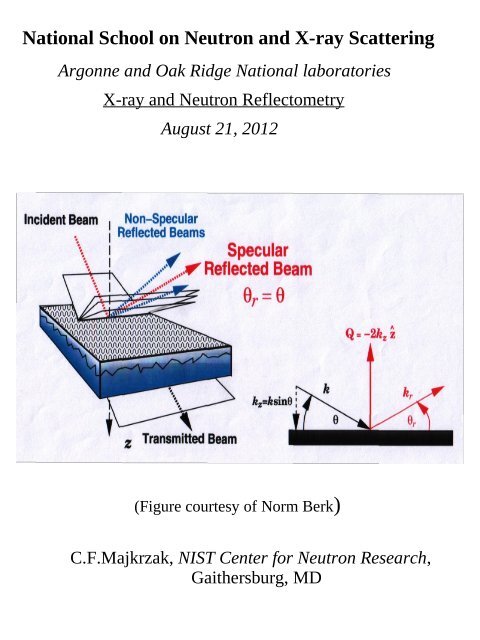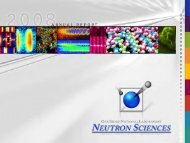Reflectivity
Reflectivity
Reflectivity
You also want an ePaper? Increase the reach of your titles
YUMPU automatically turns print PDFs into web optimized ePapers that Google loves.
National School on Neutron and X-ray Scattering<br />
Argonne and Oak Ridge National laboratories<br />
X-ray and Neutron Reflectometry<br />
August 21, 2012<br />
(Figure courtesy of Norm Berk)<br />
C.F.Majkrzak, NIST Center for Neutron Research,<br />
Gaithersburg, MD
Part 1: Basic Reflectometry Concepts<br />
diffraction versus real space imaging<br />
probing structure beneath the surface boundary<br />
wave/particle behavior<br />
coherence length -- plane waves and wave<br />
packets<br />
specular reflection from a flat object<br />
scattering length density (SLD) depth profiles<br />
spatial and Q resolutions<br />
non-specular scattering
Principal Uses and Advantages of Neutron Reflectometry:<br />
* For the specular condition, provides the chemical (isotopic) scattering<br />
length density (SLD) depth profile along the surface normal with a<br />
spatial resolution approaching half a nanometer.<br />
* With polarized neutrons, provides the vector magnetization depth<br />
profile of a ferromagnetic material.<br />
* Isotopic contrast, particularly applicable to hydrogen and deuterium.<br />
* A non-destructive probe which can penetrate macroscopic distances<br />
through single crystalline substrates, making possible reflection<br />
studies of films in contact with liquids within a closed cell.<br />
* As a consequence of the relatively weak interaction between the<br />
neutron and material, a remarkably accurate theoretical description<br />
of the reflection process and quantitative analysis of the<br />
data is possible, although the Born approximation is often not valid<br />
and an “exact” or “dynamical” formulation is required.
The great success in using neutron reflection/diffraction to study thin film systems of<br />
hard condensed matter, in particular the structures and fundamental interactions in<br />
magnetic materials, is largely due to the ability to tailor, with atomic-layer accuracy and<br />
precision, single-crystalline, layered sandwiches and superlattices (using vapor deposition<br />
techniques such as molecular beam epitaxy in ultra-high vacuum). Advances in film<br />
deposition techniques and lithography continue at a remarkable rate.<br />
> Similarly, neutron reflectometry in principle can be applied as a probe to further our<br />
understanding of the structure and function of molecules in lipid membranes, of relevance<br />
in biology and bioengineering, when comparable control over the fabrication of model<br />
systems is achieved. Great progress has been made toward realizing this goal in practice.<br />
However, we are still at a relatively early stage of development in our ability to engineer<br />
soft condensed matter films on atomic and nanometer scales. Progress can be expected as<br />
efforts in creating and manipulating membrane / molecular systems accelerates.<br />
> Employing phase-sensitive methods in reflectivity measurements ensures a unique<br />
scattering length density (SLD) depth profile. Additional application of hydrogen /<br />
deuterium substitution techniques and comparison with molecular dynamics calculations<br />
assures a correspondingly high degree of certainty of obtaining an unambiguous chemical<br />
composition depth profile.
Why is specular neutron reflectometry so special?<br />
Neutron reflectometry (NR) is a valuable probe of the<br />
structure of both hard and soft condensed matter in thin film<br />
or multilayered form -- particularly for hydrogenous and<br />
magnetic materials. NR can see beneath the surface and<br />
provide quantitative structural information from everywhere<br />
within the film on a nanometer scale.<br />
Both “forward” and “inverse” scattering problems for<br />
specular neutron reflection are mathematically solvable,<br />
exactly, from first-principles quantum theory. The<br />
mathematically unique solutions are thus far only possible in<br />
one dimension and for non-absorbing potentials of finite<br />
extent.<br />
Phase-sensitive neutron specular reflectometry,<br />
employing references, enables direct inversion of composite<br />
reflectivity data sets to yield a unique scattering length<br />
density depth profile for an “unknown” film of interest,<br />
without fitting or any adjustable parameters.<br />
The spatial resolution and accuracy of the SLD profile<br />
thereby obtained is limited only by the statistical uncertainty<br />
in the measured reflected intensities and truncation of the<br />
reflectivity data sets at the maximum value of wavevector<br />
transfer attainable.
Water wave diffracting through a double aperture (from left to right) – B.Crowell,<br />
Light and Matter, www.vias.org/physics.
Wave interference patterns produced by monochromatic laser light diffracting through<br />
a triple slit aperture for various intensities – L.Page (www.vias.org/physics). This is a<br />
dramatic illustration of wave-particle duality.
(abyss.uoregon.edu)
(Courtesy of Norm Berk)
Qzc = SQRT(16*pi*rho) (Courtesy of Norm Berk)
Polarized neutron reflectometer at NIST
Diblock copolymer lamellar nanostructures –<br />
R.Jones, B.Berry, and K.Yager (NIST Polymer<br />
Division) and S.Satija, J.Dura, B.Maranville et al.<br />
(NCNR).<br />
F i g 1 . S i d e - v i e w s c a n n i n g - e l e c tr o n m i c r o g r a p h o f l a s e r - i n te r fe r o m e tr<br />
w i t h 4 0 0 n m c h a n n e l s , s p a c e d b y 4 0 0 n m f o r a t o t a l r e p e a t d i s t a n c e o
Neutron diffraction from silicon with channels but without polymer.
F i g 2 . D i a g r a m o f e x p e c t e d o r i e n t a t i o n o f l a m e l l a e<br />
S i l i c o n s u b s t r a t e w i t h e t c h e d c h a n n e l s i s d i s p l a y e d<br />
c o r r e s p o n d i n g t o t h e t w o p o l y m e r c o m p o n e n t s o f t h
Neutron diffraction from Si channels filled with ordered diblock copolymer.
Part 2: The Phase problem, Direct Inversion<br />
and Simultaneous Fitting<br />
ambiguous SLD profiles from reflected<br />
intensities<br />
measurement of reflection amplitude via<br />
references yields unique solution -- one-toone<br />
correspondence with SLD profile<br />
given the reflection amplitude, exact, firstprinciples<br />
inversion to obtain unique SLD<br />
profile for specular reflection is possible<br />
simultaneous fitting of multiple composite<br />
(sample + reference) reflectivity data sets<br />
can lead to unambiguous solution as well
Repeated fits of reflectivity data from a Ti/TiO film system on<br />
a Si substrate in contact with an aqueous reservoir (Berk et al.).
“Statistical Analysis of Phase-Inversion Neutron Specular<br />
<strong>Reflectivity</strong>”, N.F.Berk and C.F.Majkrzak, Langmuir 25,<br />
4132 (2009).
Part 3: Applications of NR to studies of the<br />
nano-scale structure of thin film materials<br />
Soft condensed matter:<br />
-- polymers<br />
-- bio-membranes<br />
-- organic photo-voltaic films<br />
. . .<br />
Hard condensed matter:<br />
-- magnetic materials (to be discussed in<br />
a following lecture)<br />
-- chemical interdiffusion (e.g., 58Ni/62Ni)<br />
-- metal hydrides<br />
. . .
Schematic representation of tethered bilayer<br />
being used as a support for trans-membrane<br />
type proteins in structural studies using NR<br />
(Courtesy David Vanderah et al.).
(From work of Anton Le Brun, Stephen Holt,<br />
Jeremy Lakey, et al.)
(Work of Ursula Perez-Salas, K. Faucher, E. Chaikof,<br />
et al.)
B.J.Kirby et al., Phase-sensitive specular neutron<br />
reflectometry . . ., Current Opinion in Colloid & Interface<br />
Science 17 (2012) 44-53.<br />
C.F.Majkrzak et al., J. Appl. Phys. 110 (2011).<br />
www.ncnr.nist.gov -- look here for information about<br />
neutron reflectometry in general as well as in specific<br />
studies highlighted in past and current annual reports for<br />
the facility.
“Structural Investigations of Membranes in Biology<br />
by Neutron Reflectometry”, C.F.Majkrzak,<br />
N.F.Berk, S.Krueger, and U.A.Perez-Salas, Chapter<br />
12 in Neutron Scattering in Biology, Edited by<br />
J.Fitter, T.Gutberlet, and J.Katsaras, (Springer,<br />
Berlin, 2006) p.225-263.<br />
“Polarized Neutron Reflectometry”, C.F.Majkrzak,<br />
K.V.O'Donovan, and N.F.Berk, Chapter 9 in<br />
Neutron Scattering from Magnetic Materials, Edited<br />
by T.Chatterji, (Elsevier, Amsterdam, 2006) p.397-<br />
471.<br />
“Phase-Sensitive Neutron Reflectometry”,<br />
C.F.Majkrzak, N.F.Berk, and U.A.Perez-Salas,<br />
Langmuir 19, 7796 – 7810 (2003).

















